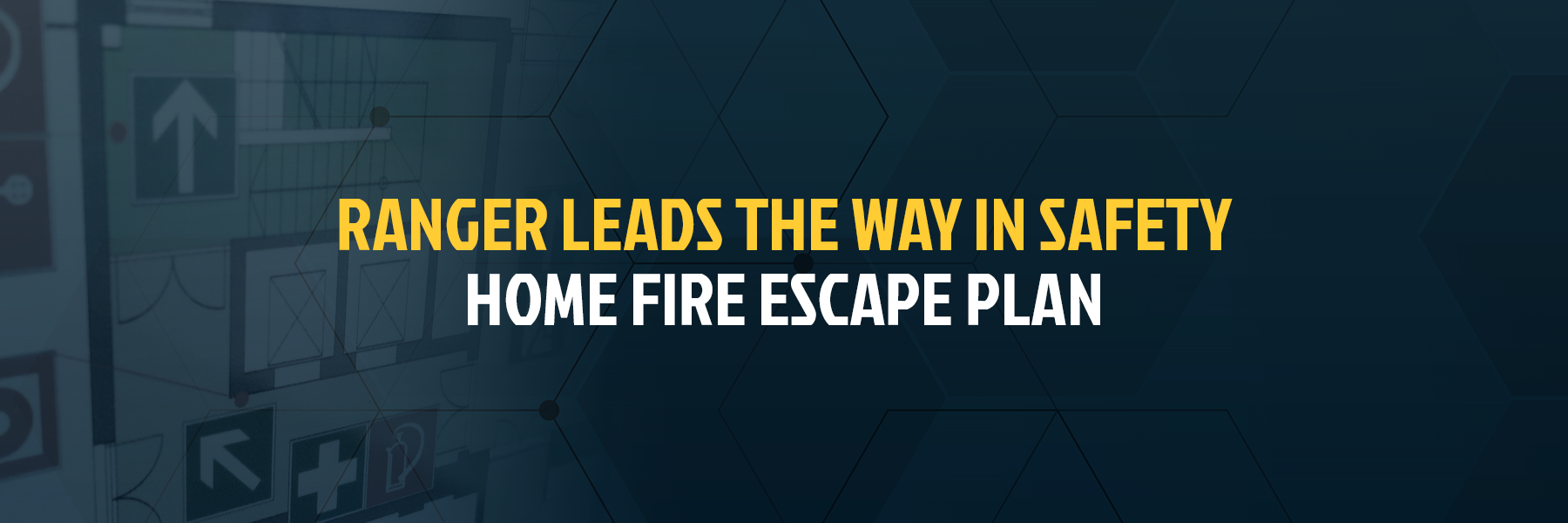Just as our Ranger family does safety planning on the job, everyone should also periodically review safety plans with their families at home.
Fire can spread rapidly through your home, leaving you as little as one or two minutes to escape safely once the smoke alarm sounds. Pull together everyone in your household and make a plan. Walk through your home and inspect all possible exits and escape routes. Households with children should consider drawing a floor plan of their home, marking two ways out of each room, including windows and doors.
Here are some general tips from the NFPA.org site (National Fire Protection Association)
Escape planning tips
- Make a plan with all members of your home
- Ensure there is a smoke detector in every sleeping room, outside every sleeping area and on every level. Also, make sure they are interconnected so when one sounds, they all sound.
- Choose an outdoor meeting place.
- Make sure your address is clearly visible from the street for emergency vehicles, and make sure everyone in the home knows the correct numbers to call in case of an emergency.
- If there are infants, older adults, or family members with mobility limitations, make sure that someone is assigned to assist them in the fire drill and the event of an emergency. Assign a backup person, too, in case the designee is not home during the emergency
- If windows or doors in your home have security bars, make sure that the bars have emergency release devices inside so that they can be opened immediately in an emergency.
- Tell guests or visitors to your home about your family’s fire escape plan. When staying overnight at other people’s homes, ask about their escape plan. If they don’t have a plan in place, offer to help them make one. This is especially important when children are permitted to attend “sleepovers” at friends’ homes.
- Be fully prepared for a real fire: get out immediately when a smoke alarm sounds.
- Once you’re out, stay out! Under no circumstances should you ever go back into a burning building. If someone is missing, inform the fire department dispatcher when you call. Firefighters have the skills and equipment to perform rescues.
Put your plan to the test
- Practice your home fire escape plan twice a year, making the drill as realistic as possible.
- Make arrangements in your plan for anyone in your home who has a disability.
- Allow children to master fire escape planning and practice before holding a fire drill at night when they are sleeping. The objective is to practice, not to frighten, so telling children there will be a drill before going to bed can be as effective as a surprise drill.
- During the drill, it’s important to determine whether children and others can readily wake to the sound of the smoke alarm. If they fail to awaken, make sure that someone is assigned to wake them up as part of the drill and in an actual emergency.
- If your home has two floors, every family member (including children) must be able to escape from the second floor rooms. Escape ladders can be placed in or near windows to provide an additional escape route. Review the manufacturer’s instructions carefully so you’ll be able to use a safety ladder in an emergency. Practice setting up the ladder from a first floor window to ensure you can do it correctly and quickly. Children should only practice with a grown-up and only from a first-story window. Store the ladder near the window in an easily accessible location. You don’t want to have to search for it during a fire.
- Always choose the safest escape route – the one with the least amount of smoke and heat – but be prepared to escape under toxic smoke if necessary. When you do your fire drill, everyone in the family should practice getting low and going under the smoke to your exit.
- Closing doors on your way out slows the spread of fire, giving you more time to escape safely.
- In some cases, smoke or fire may prevent you from exiting your home or apartment building. To prepare for an emergency like this, practice “sealing yourself in for safety” as part of your home fire escape plan. Close all doors between you and the fire. Use duct tape or towels to seal the door cracks and cover air vents to keep smoke from coming in. If possible, open your windows at the top and bottom so fresh air can get in. Call the fire department to report your exact location. Wave a flashlight or light-colored cloth at the window to let the fire department know where you are located.
Clear Your Escape Routes
Items that block doors and windows in your home could keep you from escaping in the event of a home fire. And that could mean the difference between life and death. So unblock your exits today! The key to your family’s safety is planning and practicing a home fire escape plan twice a year. Start by identifying two escape routes out of each room, if possible, then make sure that each of those escape routes can be used safely by everyone
Safety is an integral part of everything we do at Ranger Energy Services. We teach our employees how to be safe at work so they will return home safely to their families, but that safety doesn’t stop when they leave the rig site. We encourage our employees to look at every situation with a safety focus to keep themselves safe and their families. Safety on the job is the same as safety at home. It’s always our common goal.
When it comes to your family’s safety, we encourage you to do further research, use your own good judgment, and make safety an integral part of your family life.
For additional guidance and resources, visit the NFPA website









